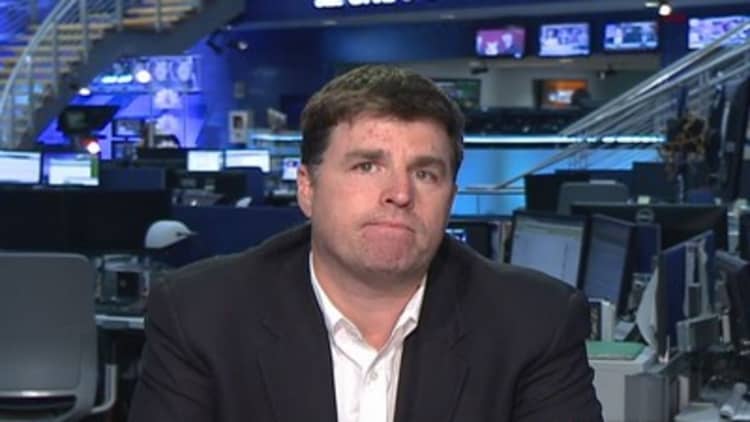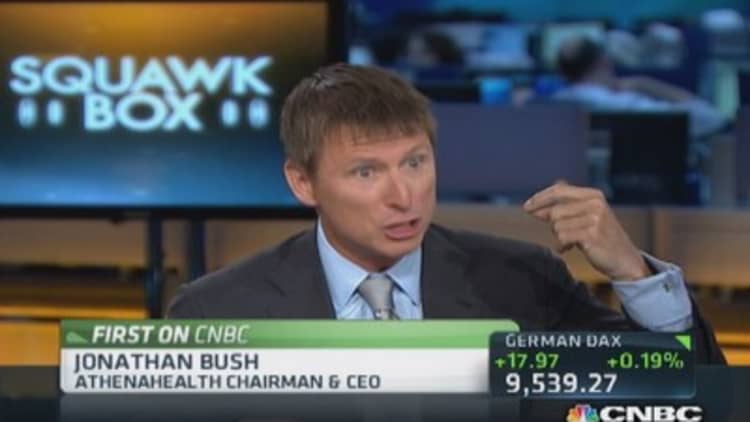
The first suggested Obamacare premium prices for 2015 don't look so scary, but a few states could soon be in for some nasty sticker shock.
Health insurers that are still processing enrollments from Obamacare signups are at the same time setting their premiums for 2015 individual policies—and setting the stage for more debate about the Affordable Care Act.
Virginia and Washington state have disclosed proposed premium rate increases for insurers for 2015, and more states could be following suit this week, according to media reports.
Trends from those two states, while not a guarantee of what will happen elsewhere, suggest that fears of double-digit average increases for Obamacare plans nationally may be overblown.
Read MoreDitch Obamacare's employer mandate? No big deal
Anthem HealthKeepers—which insures about 110,000 people in Virginia—told the state that its premiums would jump an average of 8.5 percent there, The Wall Street Journal reported Monday.
But there was a wide range of price jumps that individual buyers of Anthem HealthKeepers policies will actually see. While some customers may have rate hikes of just 0.5 percent, others will be faced with a bill that is 16.6 percent higher, the Journal said.
Another insurer in Virginia, CareFirst Blue Choice which covers 32,000 people, has filed plans to hike premiums by 14.9 percent, the Journal reported. A third insurer, Kaiser Foundation Health Plan of the Mid-Atlantic States, has a filed for a 3.3 percent increase for its policies, which currently are held by about 10,000 people in Virginia.
In the Northwest, one insurer, Molina Healthcare of Washington, has proposed a premium rate decrease—read that again, decrease—next year of 6.8 percent.
But a number of other insurers in Washington state have proposed premium rate increases.
The increases range from 0.57 percent, proposed by the Kaiser Foundation Health Plan of the Northwest, to 14.2 percent by Group Health Options. The second-highest proposed hike was 11.2 percent by Group Health Cooperative, while the Community Health Plan of Washington is proposing an 8.4 percent increase.
In a story posted Monday, the news site Vox.com noted the Washington state premium filings, and pointed out that two new insurers, Columbia United Providers and UnitedHealthcare, have also entered that market. The Vox report said the arrival of those insurers is "a potential sign that the market is viewed as healthy."
Obamacare advocates, including President Barack Obama himself, have repeatedly noted that health insurance premiums routinely go up every year, and did so long before the passage of the Affordable Care Act. The ACA now bars insurers from charging the less-healthy more than the healthy.
Percentage increases of less than double digits are likely to be cited by ACA proponents as proof that the health-care reform law is not imposing too much of a burden on insurance consumers, who this year must have health coverage or face a tax penalty.
Read MoreFlying cancer patients for free
Those boosters were heartened by the fact that national enrollment in Obamacare plans reached 8 million people, a level that they hope will help keep price increases moderate.
But opponents have argued that the law is likely to cause double-digit price hikes that will make the insurance plans unaffordable for many people.

As the filings in Virginia and Washington state suggest, there will be a broad range of premium increases, with some double-digit hikes on the top end.
And the National Journal, in a story posted Monday, identified several states that "are at risk for big premium hikes," because of their subpar enrollment so far, disproportionately higher sign-ups by older and sicker people and lack of competition among insurance companies.
"West Virginia sticks out as really worrisome," Caroline Pearson, vice president of the consulting firm Avalere Health. "Their [Obamacare] exchange is not having great luck."
The National Journal noted that West Virgina fell short of its enrollment target by 40 percent, had the lowest level of enrollment in the nation by young adults—just 19 percent—and has just a single carrier in the state selling policies on the Obamacare exchange, Blue Cross Blue Shield.
Hawaii is another state snakebit both by low overall enrollment and very low enrollment by young adults.
Other states mentioned by the National Journal for possibly big premium price increases were Ohio, Arizona and Iowa, for, among other things, allowing extensions of plans that originally were supposed to have been canceled by the ACA as of this year. Such extensions could keep large numbers of people out of the risk pools in plans sold on the Obamacare exchanges.
Read MoreMedicaid expansion could cost states less
The other states were Maryland, Mississippi, New Mexico and South Dakota.
Because enrollment in Obamacare plans continued through April and because rates need to be submitted in the next few months, insurers and actuaries are dealing with less information than they are accustomed to in setting premiums.
Many Obamacare enrollees signed up in the last two months. As a result, insurers do not have much information on the overall health profile of their new customers and how likely they are to use benefits.
The danger facing insurers is that if they set next year's premiums too low, it will not be enough to offset the cost of paying benefits for their customers. But if they set prices too high, then it may hold down enrollment and let their competitors steal market share.
—By CNBC's Dan Mangan.


